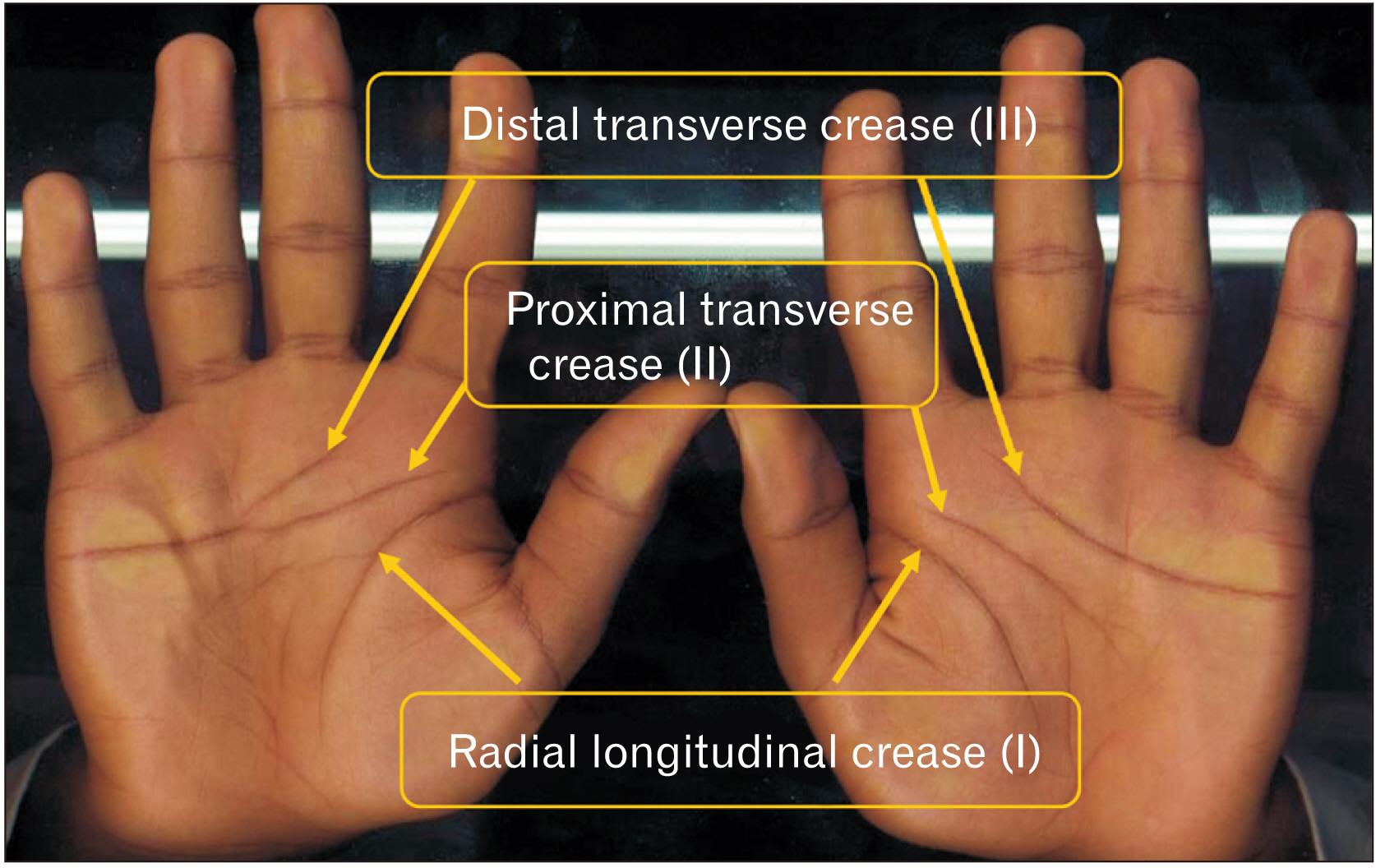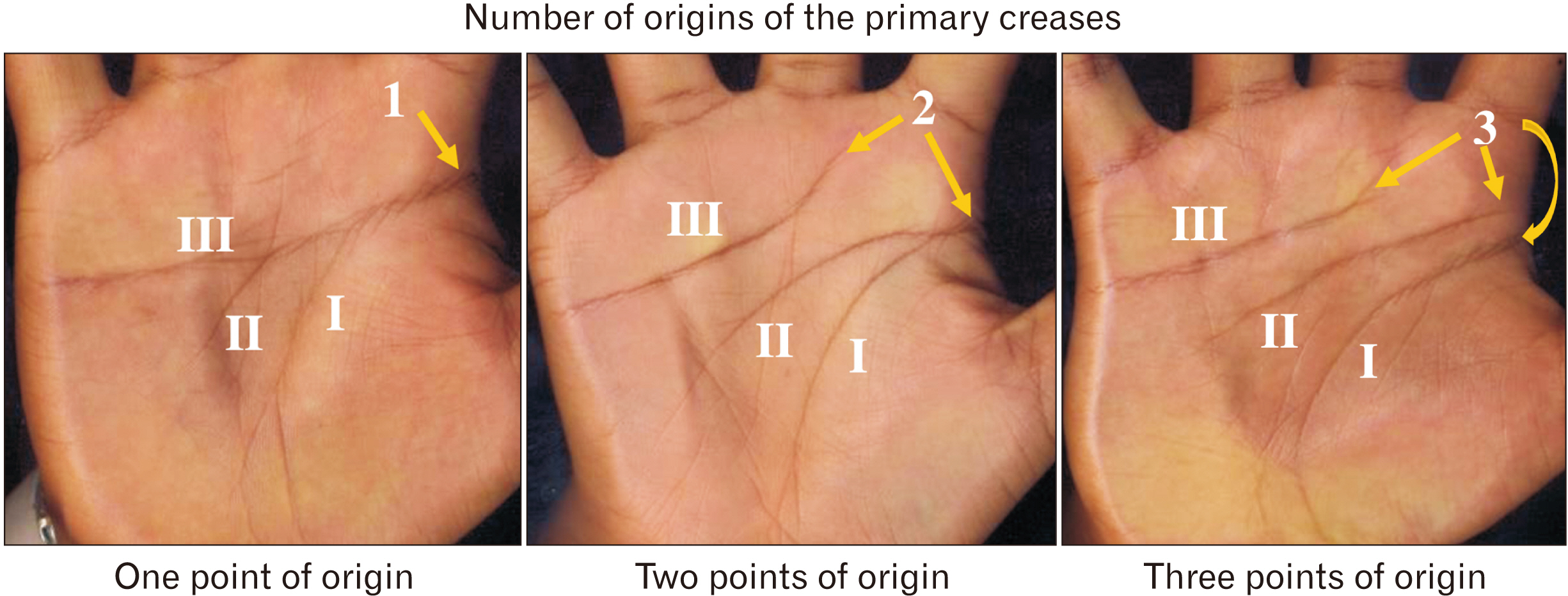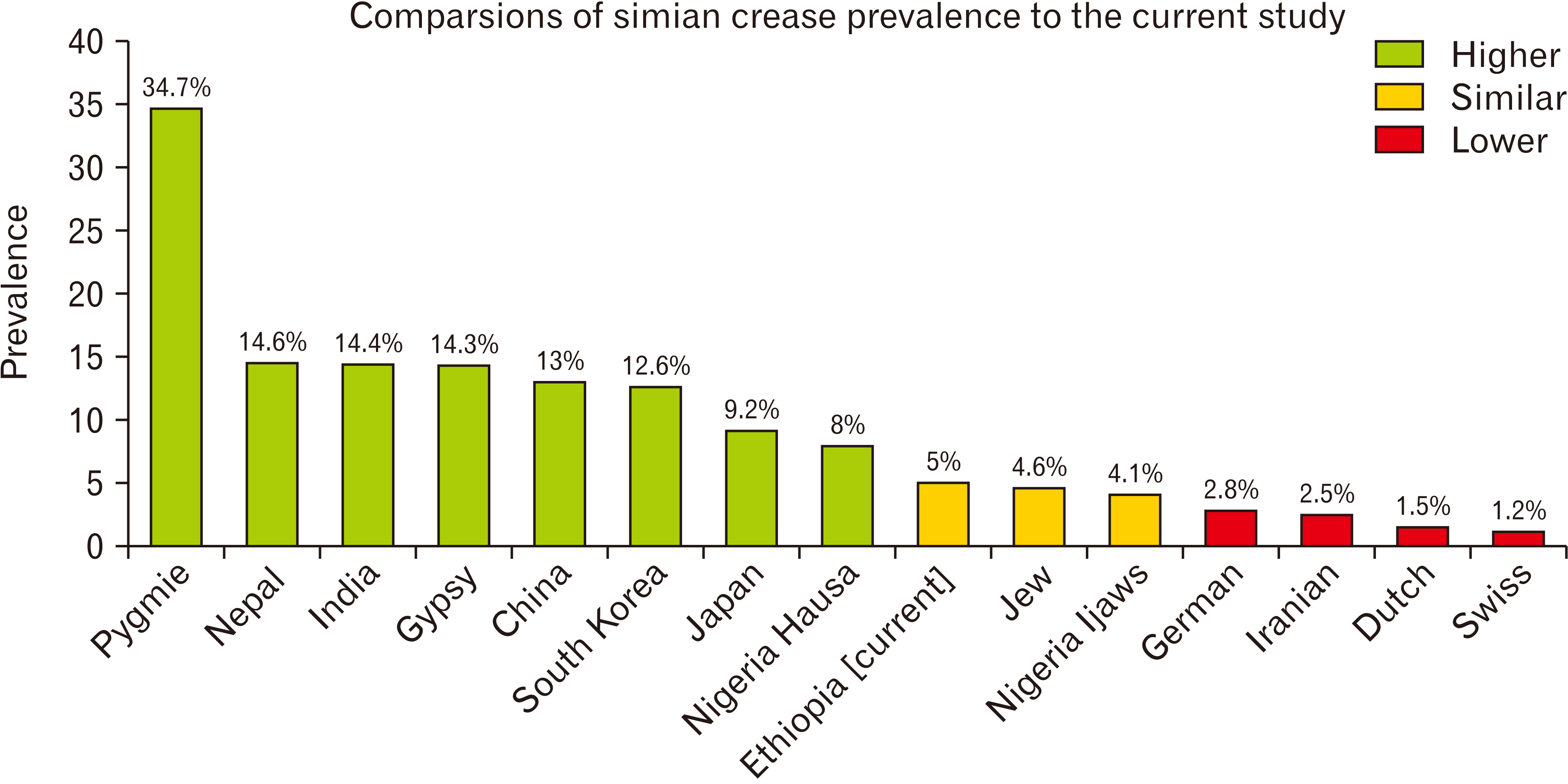Anat Cell Biol.
2022 Jun;55(2):161-169. 10.5115/acb.21.251.
Prevalence of palmar crease patterns and associated factors among students at University of Gondar, Northwest Ethiopia
- Affiliations
-
- 1Department of Human Anatomy, College of Medicine and Health Sciences, University of Gondar, Gondar, Ethiopia
- 2Department of Epidemiology and Biostatistics, Institute of Public Health, College of Medicine and Health Sciences, University of Gondar, Gondar, Ethiopia
- KMID: 2531203
- DOI: http://doi.org/10.5115/acb.21.251
Abstract
- Palmar creases are unique, permanent, and genetically controlled morphological variables. Recognizing palmar crease types are important for personal identification, criminal investigations, and diagnosis of congenital diseases. This study aimed to reveal the anthropological characteristics as well as contribute to the diagnosing of congenital disease of Ethiopian people. In this study, a cross-sectional study design with a multistage sampling technique were used. Chi-square test, bivariable, and multivariable multinomial logistic regression models were employed. At bivariable analysis variables with a P-value of ≤0.2 were selected for multivariable analysis and at multivariable analysis variables with a P-value of ≤0.05 were considered as statistically significant factors. Most of study participants had normal palmar crease patterns (90.8%), followed by simian crease patterns (5.0%), whereas sydney crease patterns was the least (1.92%). Being male was more likely to have simian crease and sydney crease than normal crease. Right-handed subjects were less likely to have simian crease and suwon crease than normal crease. The simian crease was more common among students whose fathers were from Gurage ethnicity than normal creases. Students who have one point of origin of the primary palmar creases were more likely to have simian crease, sydney crease, and suwon crease than normal crease. In this study, the normal type of palmar crease patterns was the most prevalent. Whereas the simian crease pattern was the commonest type among the variant palmar creases. Palmar crease patterns are affected by sex, ethnicity, handedness, and points of origin of the primary palmar crease.
Keyword
Figure
Reference
-
References
1. Chauhan P, Kalra S, Jain SK, Munjal S, Anurag A. 2011; Relationship between palmar skin creases and osseous anatomy - a radiological study identification. J Morphol Sci. 28:184–8.2. Oyinbo CA, Fawehinmi HB. 2009; Prevalence of simian and Sydney creases in the Ijaws of South-South Nigeria. Internet J Biol Anthropol. 3:2. DOI: 10.5580/1a51.3. Chaube R. 1977; Palmar creases in population studies. Am J Phys Anthropol. 47:7–9. DOI: 10.1002/ajpa.1330470104. PMID: 888935.
Article4. Offei EB, Abledu JK, Osabutey CK, Kesse DK. 2014; Relationship between palmar dermatoglyphic pattern and academic performance of students in a Ghanaian secondary school. J Med Biomed Sci. 3:24–31. DOI: 10.4314/jmbs.v3i2.5.
Article5. idevi NS Sr, Delphine Silvia CR, Kulkarni R, Seshagiri C. 2010; Palmar dermatoglyphics in carcinoma breast of Indian women. Rom J Morphol Embryol. 51:547–50. PMID: 20809035.6. Taye M, Gelaw B, Dessalegn K, Befekadu A, Abuhay M. 2016; The prevalence and pattern types of palmar digital dermatoglyphics and ridge counts among students of University of Gondar, Northwest Ethiopia. Int J Anat Radiol Surg. 5:AO01–7. PMID: 03405220e36b4bdb832853c300086651.7. Park JS, Shin DS, Jung W, Chung MS. 2010; Improved analysis of palm creases. Anat Cell Biol. 43:169–77. DOI: 10.5115/acb.2010.43.2.169. PMID: 21189999. PMCID: PMC2998791.
Article8. Sharma DK, Sharma V. 2011; Prevalences of Simian, Sydney and Suwon creases and their association with each other, body sides, handedness, sex and anomalies/diseases/syndromes in a population of Central India. Int J Morphol. 29:1069–75. DOI: 10.4067/S0717-95022011000300069.
Article9. Taura AA, Taura MG, Adamu LH. 2014; Palmar creases; a comparative study between epilepsy patients and healthy subjects among Hausas of Northern Nigeria. Am J Med Med Sci. 4:175–9.10. Blessy T, Raja DBWD. 2016; Fingerprint and intelligence- what do the studies Rseveal? Rev J Philos Soc Sci. 41:1–7.11. Malla T, Malla KK, Gauchan E, Brijesh S, Sharma R. 2010; Incidence of simian crease in normal Nepalese children. Kathmandu Univ Med J (KUMJ). 8:410–4. DOI: 10.3126/kumj.v8i4.6241. PMID: 22610771.
Article12. Dar H, Schmidt R, Nitowsky HM. 1977; Palmar crease variants and their clinical significance: a study of newborns at risk. Pediatr Res. 11:103–8. DOI: 10.1203/00006450-197702000-00004. PMID: 138837.
Article13. Plato CC, Wertelecki W, Schwartz JT. 1976; Normal and aberrant palmar creases in twins and siblings. Acta Genet Med Gemellol (Roma). 25:174–6. DOI: 10.1017/S0001566000014070. PMID: 1036358.
Article14. Paul JN, Osunwoke EA, Paul CW. 2016; Prevalence of simian, Suwon, and Sydney creases in acquired idiopathic blindness in some selected schools for the blind in Nigeria. Ann Bioanthropol. 4:75–8. DOI: 10.4103/2315-7992.204679.
Article15. van Mensvoort M. c2004-2019. The simian line & ethnicity! [Internet]. Martijn van Mensvoort;Available from: http://simianline.handresearch.com/simianline/simian-line-ethnicity.htm. cited 2021 Aug 12.16. Kamali MS. 1985; Simian crease polymorphism among fifteen Iranian endogamous groups. Anthropol Anz. 43:217–25. PMID: 4062263.17. Hidayah M, Tjong D, Roesma D. 2016; The study of dermatoglyphic in simian crease group (The Human Masukake- Gata) at Minangkabau Ethnic, West Sumatra, Indonesia. Int J Pure Appl Biosci. 4:9–14. DOI: 10.18782/2320-7051.2199.
Article18. Purvis-Smith SG, Menser MA. 1968; Dermatoglyphics in adults with congenital rubella. Lancet. 2:141–3. DOI: 10.1016/S0140-6736(68)90422-4. PMID: 4173264.
Article19. Purvis-Smith SG. 1972; The Sydney line: a significant sign in down's syndrome. J Paediatr Child Health. 8:198–200. DOI: 10.1111/j.1440-1754.1972.tb01822.x. PMID: 4264726.
Article20. Bali RS, Chaube R. 1971; On the formulation of palmar creases. Z Morphol Anthropol. 63:121–30. DOI: 10.1127/zma/63/1971/121. PMID: 5105808.
Article21. Zhang Y. 2014. Online tool for handedness assessment [Internet]. University of Minnesota;Minneapolis: Available from: http://zhanglab.wikidot.com/handedness. cited 2021 Aug 12.22. Oldfield RC. 1971; The assessment and analysis of handedness: the Edinburgh inventory. Neuropsychologia. 9:97–113. DOI: 10.1016/0028-3932(71)90067-4. PMID: 5146491.
Article23. Chaube R. 1977; Palmar creases and diseases: cancer and tuberculosis. Acta Genet Med Gemellol (Roma). 26:293–5. DOI: 10.1017/S0001566000009806. PMID: 613696.
Article24. Alhaji MM, Timbuak J, Umana UE, Tanko M. 2015; Palmar creases and handedness in hausas of Northern Nigeria: a cross-sectional study. Asian J Biol Med Sci. 1:6–13.25. Mattison SM, Brunson EK, Holman DJ. 2015; Palmar creases: classification, reliability and relationships to fetal alcohol spectrum disorders (FASD). Coll Antropol. 39:769–74. PMID: 26898079.
- Full Text Links
- Actions
-
Cited
- CITED
-
- Close
- Share
- Similar articles
-
- Recreational Use of Phosphodiesterase 5 Inhibitors and Its Associated Factors among Undergraduate Male Students in an Ethiopian University: A Cross-Sectional Study
- Perceptions of pharmacy clerkship students and clinical preceptors regarding preceptors' teaching behaviors at Gondar University in Ethiopia
- Distribution and larval breeding habitats of Aedes mosquito species in residential areas of northwest Ethiopia
- Visceral leishmaniasis treatment outcome and its determinants in northwest Ethiopia
- Prevalence of goiter and associated factors among schoolchildren in northeast Ethiopia





